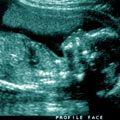Description of the test
Ultrasound technology allows doctors to see inside the body using high-frequency sound waves. These sound waves bounce off of tissues and return to the equipment, which then translates the sound waves into images of the part of the body being monitored.
Ultrasound is a useful tool to diagnose conditions or analyze certain organs. However, sound waves do not go through air or bone. If bone interferes with the image, another test (such a CT scan or an MRI) may be required.
This test takes place in a clinic, hospital, or doctor's office.
How often should the test be performed?
Your doctor will recommend when and how frequently this test is required.
Why is this test performed?
Doctors can request this test for several reasons. An ultrasound can help to guide a biopsy procedure, or it can provide information about:
- a developing fetus
- organs that may have tumours (e.g., uterus, prostate gland)
- how specific organs are functioning (e.g., heart)
- a possible infection
- blood vessels and blood flow (e.g., blood clots in the leg veins, narrowing of the arteries of the neck)
- joints in physiotherapy treatment
With results from this test, your doctor can better identify and treat medical problems.
Are there any risks and precautions?
Ultrasound is safe. There is no known risk of side effects or complications. Ultrasound uses low-energy sound waves that do not damage cells.
What happens during the test?
To start the test, you will need to remove all or some of your clothing and put on a hospital gown. You will then be asked to lie on an examination table, and a technician will place some lubricating gel on the area being examined. This gel eliminates any air pockets and provides the contact required between your skin and the device, called a transducer, which sends the sound waves into your body. The technician will move the transducer over the area.
Still images of the area as well as measurements are taken during the test. You will not feel any pain, although some people who need to have a full bladder for the test may experience some discomfort before they can urinate. A full bladder is often required for pelvic examinations of the female reproductive organs (e.g., the ovaries or uterus).
Some transducers are inserted into the body. Transvaginal ultrasounds require the insertion of the transducer into the vagina for better images of the uterus and ovaries. Transrectal ultrasounds (through the anus) look at the colon or prostate gland. Transesophageal echocardiograms allow for images of the heart by inserting a transducer into the esophagus.
Typically, an ultrasound lasts from 30 minutes to one hour.
How should I prepare for this test?
Some ultrasound tests require preparation while others do not. This depends on what area is being tested. For pelvic ultrasounds, you must drink large amounts of fluids before the test. For other ultrasounds, you may be told not to eat or drink for a certain period of time beforehand.
Follow your doctor's instructions on how to best prepare for your specific type of ultrasound.
Tell your doctor or prescriber about all prescription, over-the-counter (non-prescription), and herbal medications that you are taking. Also tell them about any medication allergies and medical conditions that you may have. Ask your doctor or pharmacist whether you need to stop taking any of your medications before the test.
What can I expect after the test?
You may need to use paper towels wipe off the lubricating gel.
The technician will forward your ultrasound to a doctor.
Results
Ask your doctor when you can expect your test results to be made available. Based on the report, your doctor will discuss the next steps (e.g., additional tests, treatment) with you.
All material copyright MediResource Inc. 1996 – 2024. Terms and conditions of use. The contents herein are for informational purposes only. Always seek the advice of your physician or other qualified health provider with any questions you may have regarding a medical condition. Source: www.medbroadcast.com/procedure/getprocedure/Ultrasound




